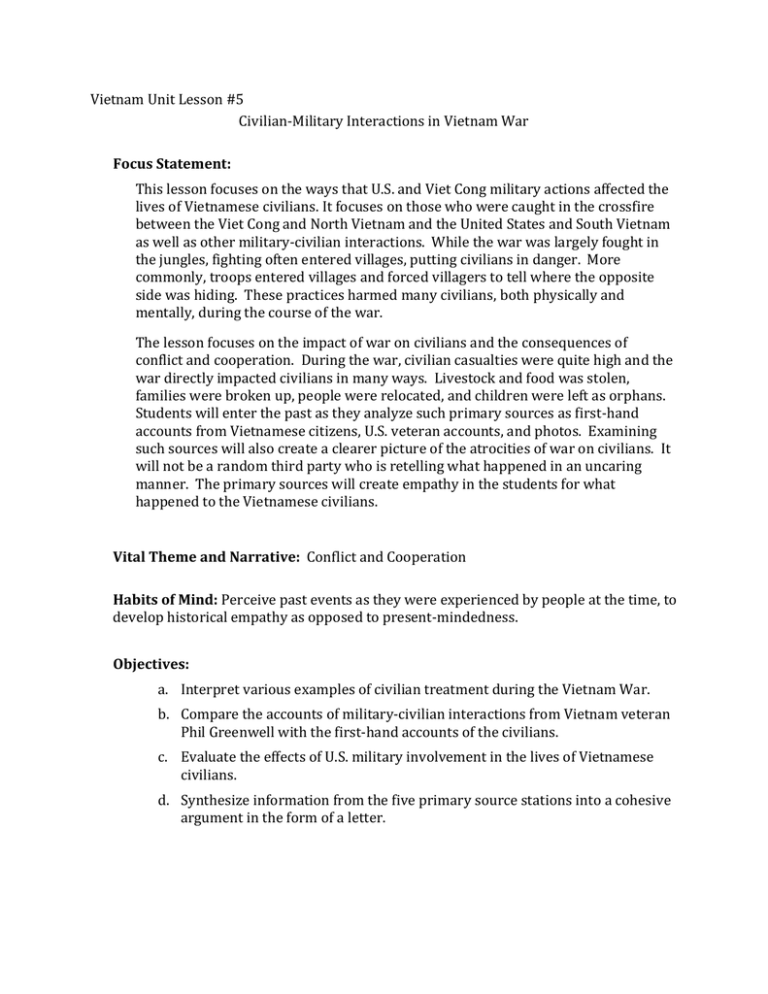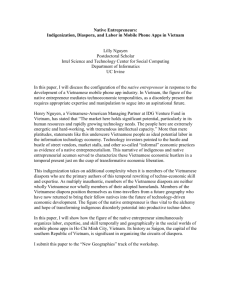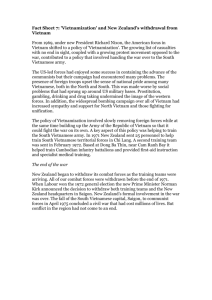Vietnam Unit Lesson #5 Civilian-Military Interactions in Vietnam War
advertisement

Vietnam Unit Lesson #5 Civilian-Military Interactions in Vietnam War Focus Statement: This lesson focuses on the ways that U.S. and Viet Cong military actions affected the lives of Vietnamese civilians. It focuses on those who were caught in the crossfire between the Viet Cong and North Vietnam and the United States and South Vietnam as well as other military-civilian interactions. While the war was largely fought in the jungles, fighting often entered villages, putting civilians in danger. More commonly, troops entered villages and forced villagers to tell where the opposite side was hiding. These practices harmed many civilians, both physically and mentally, during the course of the war. The lesson focuses on the impact of war on civilians and the consequences of conflict and cooperation. During the war, civilian casualties were quite high and the war directly impacted civilians in many ways. Livestock and food was stolen, families were broken up, people were relocated, and children were left as orphans. Students will enter the past as they analyze such primary sources as first-hand accounts from Vietnamese citizens, U.S. veteran accounts, and photos. Examining such sources will also create a clearer picture of the atrocities of war on civilians. It will not be a random third party who is retelling what happened in an uncaring manner. The primary sources will create empathy in the students for what happened to the Vietnamese civilians. Vital Theme and Narrative: Conflict and Cooperation Habits of Mind: Perceive past events as they were experienced by people at the time, to develop historical empathy as opposed to present-mindedness. Objectives: a. Interpret various examples of civilian treatment during the Vietnam War. b. Compare the accounts of military-civilian interactions from Vietnam veteran Phil Greenwell with the first-hand accounts of the civilians. c. Evaluate the effects of U.S. military involvement in the lives of Vietnamese civilians. d. Synthesize information from the five primary source stations into a cohesive argument in the form of a letter. National History Standard: USH Era 9 Standard 2C Evaluate how Vietnamese and Americans experienced the war and how the war continued to affect postwar politics and culture. [Appreciate historical perspectives] Historical Thinking Standard 3B Consider multiple perspectives. Historical Thinking Standard 4C Interrogate historical data. Procedures: Set induction: Place the picture of the young girl running from soldiers at the Na Palm attack on the overhead, and ask students to write down three adjectives that describe the image. After completing regular classroom duties introduce today’s central question: “How did U.S.-Vietnamese military interactions affect the lives of Vietnamese citizens?” Students will be divided into five groups. At each station, students will examine various primary sources. In each group students will be given questions around which to orient their viewing, listening or reading. (See enclosed station guides.) After students have evaluated the sources provided at each station, the class will come back together and discuss the students’ findings at each station based on their notes from their station guides. Together we will synthesize the information from each group and begin to craft an interpretation of how U.S.Vietnamese military interactions affected the lives of Vietnamese citizens. During this time, we will refer to each of the sources and the photo of the young girl during the Na Palm raid, and discuss the significance of each. Closure: Students will be assigned to write a letter as a Vietnamese citizen. Method of Assessment: Students will take the remaining class time to write a letter as a Vietnamese civilian to the Vietnamese government stating their position on the war. Students should also state three ways the war has affected their lives and how war has affected their role as citizens. Finally, students should state their position on the government’s role in protecting its citizens in time of war in light of the sources they previously evaluated. Materials: Cantigny Oral History Project written transcripts of interview with Phil Greenwell. Cantigny Oral History Project video Photos of Vietnamese civilians Station Organization STATION SOURCE Excerpt from Phil Greenwell transcript Station 1 55:00 – 57:00 Three excerpts from Phil Greenwell transcripts Station 2 57:00 – 59:00 Station 3 Photos of Vietnamese civilian-U.S. Military interactions Station 4 First-hand Vietnamese accounts Station 5 First-hand Vietnamese accounts STATION ONE GUIDE Phil Greenwell is a Vietnam veteran who is being interviewed by students and faculty from Ball State University as part of the Cantigny Oral History Project. 1. What role did civilians play in providing information to military personnel? 2. How important is public support in winning a war? 3. Who were the Vietnamese loyal to? STATION TWO GUIDE Phil Greenwell is a Vietnam veteran who is being interviewed by students and faculty from Ball State University as part of the Cantigny Oral History Project. 1. How did the war affect the livelihoods of Vietnamese civilians? Why? 2. Does it seem that U.S. soldiers were concerned with the lives of civilians? 3. How lasting was war devastation to Vietnamese civilians? 4. What was the civilian curfew? Who instituted it? STATION THREE GUIDE 1. In what ways did U.S. military personnel affect the lives of Vietnamese civilians? 2. What kinds of people were affected by the war (as shown in the pictures)? 3. Was the U.S. a positive or negative presence to civilians? Why? STATION FOUR GUIDE The following excerpts are first-hand accounts from Vietnamese civilians Nguyen Ngoc Luong, Tran Luong and Bong Macdoran. 1. The first two accounts do not speak of direct wounds received by either person. However, it speaks of problems that affected the civilian population. What were these problems? 2. Do you think the problems from the question above are worse or better problems than civilians being potentially caught in crossfire such as the third account? Why? 3. The majority of these accounts were injured or saw injuries inflicted by the Americans. Do you think all the blame can be laid on Americans? How much do you think Americans should be blamed? STATION FIVE GUIDE The following excerpts are first-hand accounts from Vietnamese civilians Le Cao Dai Huynh and Phuong Dong. 1. Which side were these two individuals on? 2. How were their experiences similar to each other? How were they different? 3. Do you think the American pilots who bombed or sprayed Agent Orange were aware of the effects upon the civilians? Excerpts from the book Patriots by Christian Appy Each is an account from a Vietnamese talking of their time in the Vietnam War. Nguyen Ngoc Luong: worked as an interpreter and for the Saigon Daily News “I spent a lot of time going to bars near my home. That was the way to get to know American soldiers and Vietnamese bar girls. Most of the bar girls were from the countryside. Because of the fighting there they had to run away to the city. They couldn’t find anything to do, so step-by-step they became bar girls. They didn’t understand anything about the war. They thought, we don’t know why we are punished this way. We didn’t do anything wrong. Maybe our ancestors did something wrong so now we are punished. It was confusing for all of us, not just for the bar girls. The GIs didn’t understand anything at all about Vietnam. They always talked about being here for just one year…” Tran Luong: child who was evacuated to the countryside due to the bombing in Hanoi. “When the American bombing started we had to hide in the countryside. The government sent most of the rice to the troops so we ate everything we could find. The villagers taught me how to catch animals underwater by hand… There was no real school. The older people just taught us informally at night underground by the light of a small oil lamp. A few times, for short periods, I went to school with other children, but we never gathered in large groups during the day. If you did, bombs would start falling in about fifteen minutes, and in the countryside there were no sirens to warn you of air strikes… The morning after the bombing [Christmas bombing] I went to Kham Thien Streeet with some older children. I saw pieces of hair and scalp hanging on trees. It was an indelible sight.” Bong Macdoran: hurt as a child and was adopted by a couple in the US. She was injured early in the war from bullets that had hit an arm, shoulder, and ankle. A shrapnel explosion ripped into her face. “When I was young people would say, ‘Oh, were you in a car accident?’ I’d say, ‘No, actually I was in the Vietnam War.’ That usually sufficed. Most people didn’t want to go any further and I didn’t have any more information. Excerpts from the book Patriots by Christian Appy Each is an account from a Vietnamese talking of their time in the Vietnam War. Le Cao Dai: A doctor who directed the largest jungle hospital in the Central Highlands “…But the Americans launched innumerable chemical spraying operations to defoliate the jungle. As soon as they sprayed nearby I’d give the order to begin moving the hospital. Even so, we were sometimes spotted by US helicopters or observation planes and then the B-52s would inevitably attack that very night… About seventy percent of our patients were in the hospital for non-combat related diseases. The most common, by far, was malaria. Almost everyone got it, including the doctors and staff. I was no exception. Three to six months of sickness. The Highlands were extremely malarial. Oddly enough, in 1964 and ’65, before I arrived, I heard it wasn’t such a serious problem. But in 1966, it just soared. I couldn’t explain it at the time. Now I suspect it may be linked to some weakening of our immune systems caused by exposure to Agent Orange. In any case, there was a much higher incidence of malaria after the heavy spraying of chemical defoliants. Many people died, especially those who contracted an especially severe type of malaria that makes you urinate blood and vomit bile in addition to the usual terrible fevers and other symptoms. The only effective treatment would be to relieve the kidney function through dialysis. Of course there was no way to do that in the jungle… No one knows how many Vietnamese have died from diseases caused by Agent Orange, but according to our studies, one million people still suffer from cancers linked to Agent Orange exposure and there are about one hundred thousand people still alive with birth defects that we believe were caused by dioxyn poisoning. We’ve seen many kinds of birth defects.” Huynh Phuong Dong: worked as a nurse, doctor’s aide, and eventually a physician “If we were performing an operation we had to carry on even in the midst of bombing strikes. We were under explicit orders not to abandon our patients. They were not to die alone… In those days everyone hated the Americans. We could accept that the Americans would attack military bases for military purposes, but they even attacked hospitals, civilian centers, and dikes. There were a lot of civilian casualties, so naturally we were full of anger.” Images used Axelrod, B.L., photographer. “Vietnam....Vietnamese children of the Phong Dien refugee hamlet peer through a fence. There are 126 families, 10 sisters, 250 children from 6 years to 15, and 115 children under 6 years old in the village.” Photograph. 1967. From the National Archives. http://media.nara.gov/media/images/36/30/362982a.gif (accessed November 24, 2009). Fleetwood, SSgt., photographer. “Vietnam....A Marine rifleman with Company H, 2nd Battalion, 5th Marines, Leaps across a break in a rice paddy dike during a search and destroy mission on Operation Colorado.” Photograph. 1966. From the National Archives. http://media.nara.gov/media/images/36/30/36-2950a.gif (accessed November 24, 2009). Hastie, Mike, photographer. “Untitled.” Photograph. (n.d.) From TheWE.cc. http://www.thewe.cc/thewei/_/vietnam/elderly_vietnam_alive_victim_us_war.jpe (accessed November 24, 2009). Lookabaugh, LCpl., photographer. “Men of H Company, 2nd Battalion, 7th Marines, move along rice paddy dikes in pursuit of the Viet Cong.” Photograph. 1965. From the National Archives. http://media.nara.gov/media/images/36/30/36-2919a.gif (accessed November 24, 2009). “Napalm bombs explode on Viet Cong structures south of Saigon in the Republic of Vietnam.” Photograph. 1965. From the National Archives. http://media.nara.gov/media/images/36/31/36-3010a.gif (accessed November 24, 2009). Prentis, A. C., photographer. “Vietnam....Corporal M.R. Carter guards an NVA soldier he captured during a ground movement ten miles northeast of An Hoa.” Photograph. 1968. From the National Archives. http://media.nara.gov/media/images/36/30/362978a.gif (accessed November 24, 2009). “Saigon, South Vietnam....Staff Sergeant Ermalinda Salazar, a woman Marine, has been nominated for the 1970 Unsung Heroine Award presented annually by the Ladies Auxillary to the veterans of foreign wars. Staff Sergeant Salazar, determined to help the children of the St. Vincent de Paul Orphanage in Vietnam in her off-duty hours, holds two of the youngsters.” Photograph. 1970. From the National Archives. http://media.nara.gov/media/images/36/30/36-2974a.gif (accessed November 24, 2009). “Stunned by the viciousness of a Viet Cong attack on their village, Vietnam war refugees ride an Air Force helicopter to a safe area near Saigon.” Photograph. 1966. From the National Archives. http://media.nara.gov/media/images/28/7/28-0623a.gif (accessed November 24, 2009). “Untitled.” Photograph. (n.d.) From HistoryPlace.com. http://www.historyplace.com/unitedstates/vietnam/slideshow/viet-show10.jpg (accessed November 24, 2009). --This photo courtesy The History Place (historyplace.com). Other recommended images: http://pro.corbis.com/Enlargement/Enlargement.aspx?id=BE020186&ext=1 - Nick Ut’s Pulitzer Prize winning Trang Bang photograph.
![vietnam[1].](http://s2.studylib.net/store/data/005329784_1-42b2e9fc4f7c73463c31fd4de82c4fa3-300x300.png)





